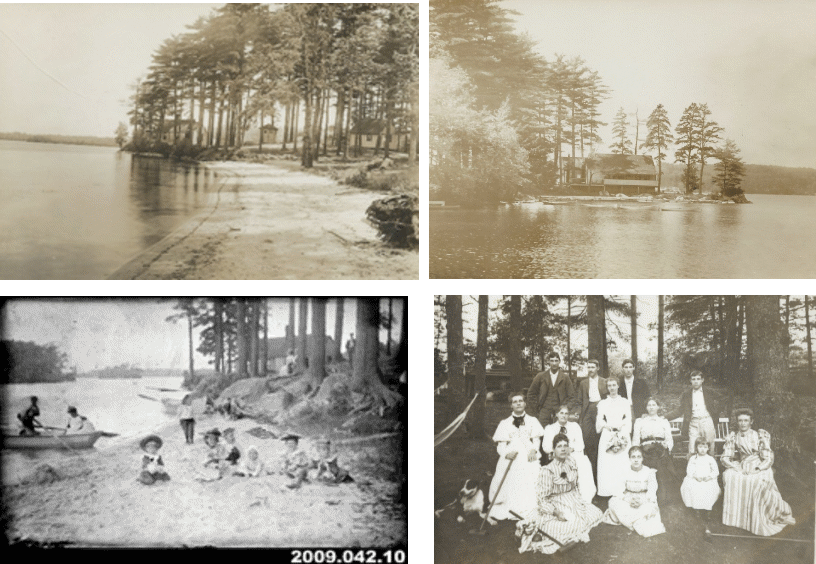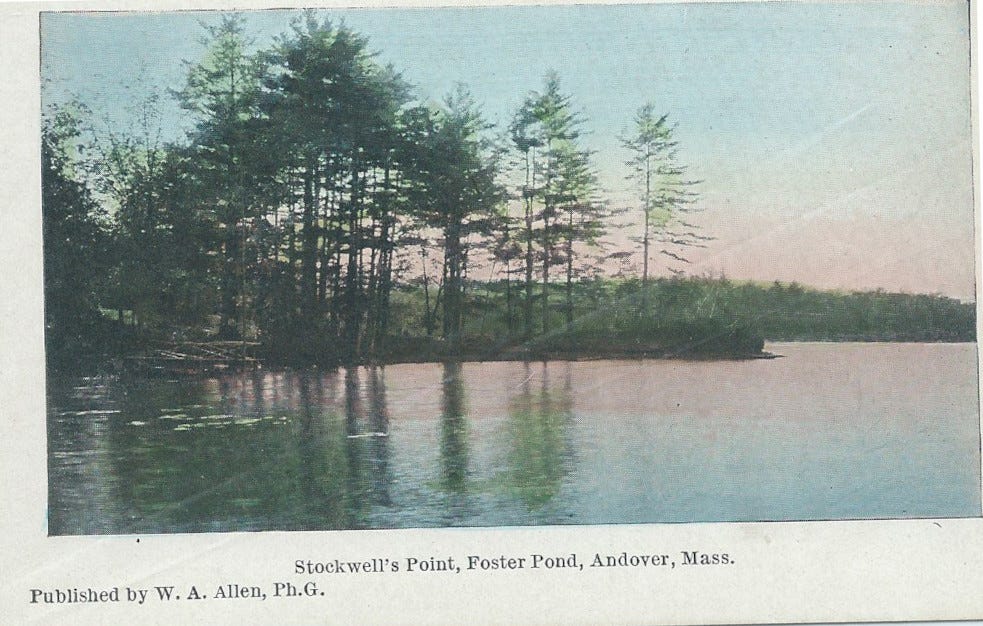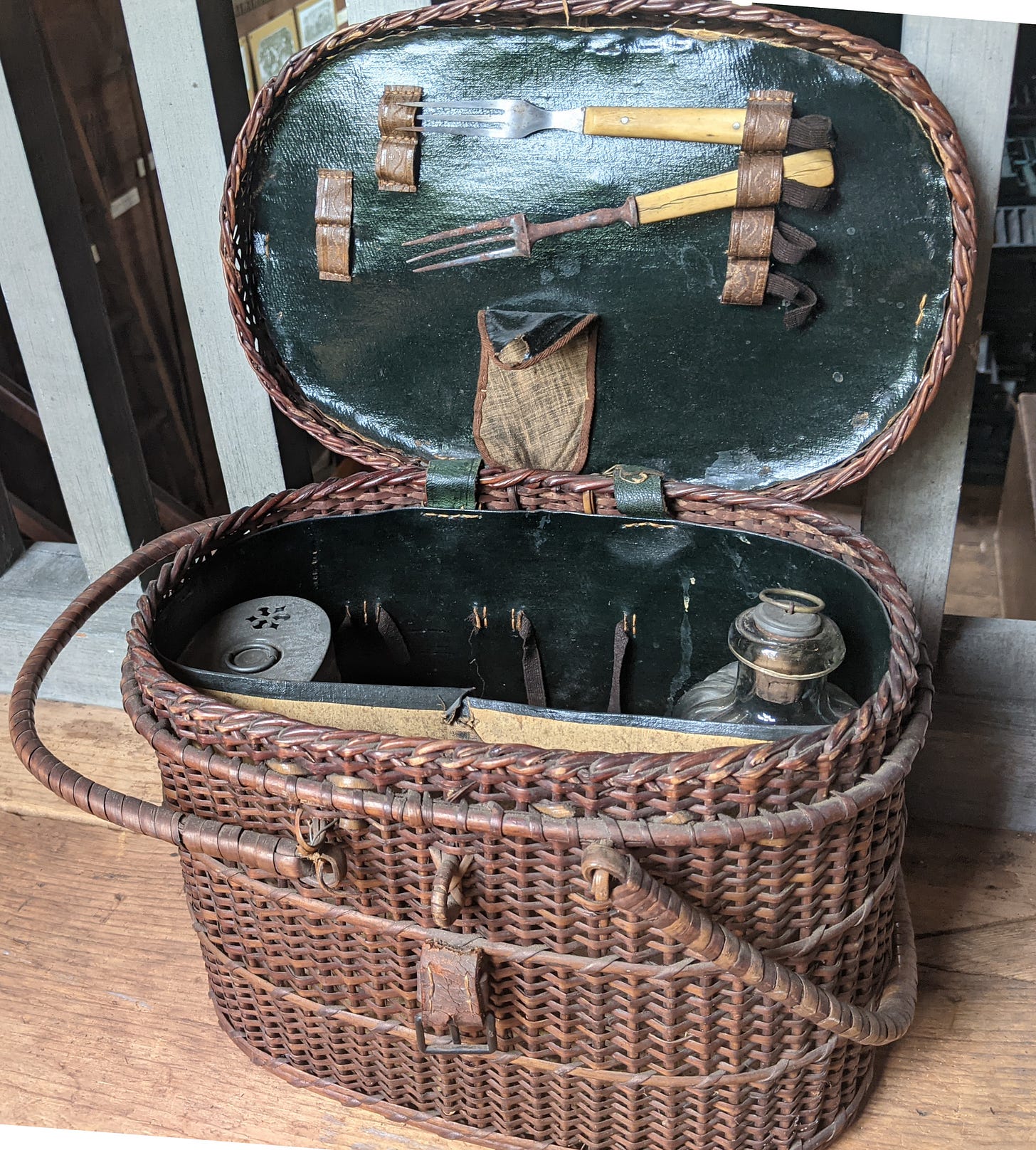Miscellany Mondays: It's picnic time!
Despite the presence of chaperones, many 19th century picnics and activities were were designed to promote romance.
It’s August and my mind turns to outdoor activities and picnics. A friend and I have a tradition of meeting in a park midway between the two of us. We each pack whatever we feel like cooking and eating and somehow the menu always works out. We’ve never had too much of one type of food and not enough of another.
Inspired by happy memories of picnics, I went down a pleasant research rabbit hole on late 19th century picnics.
Picnicking in Andover
Andover had a number of popular picnic spots in the late 1800s.
Bellevue Grove and Bailey’s Shady Grove were both on Haggett’s Pond in west Andover.
Bailey’s Shady Grove, owned and managed by Samuel Gilman Bailey, featured picnic areas, a dance pavilion, boating, swimming, a cookhouse, restaurant, and in 1872, an ice house.
Bailey’s Shady Grove “was a popular daytime picnic resort on the pond that was rented out to local residents, groups and organizations for family gatherings, church picnics and to businesses for employee outings.” (Andover Historic Preservation)
16-year-old diarist Abby Locke wrote this entry in her diary on July 4, 1867:
Thursday 4: Went to a picnic at Haggetts Pond. Had a glorious time. Danced all the time. Went out in a boat once with Amasa Clarke. He invited me to ride home with him and of course I accepted. It rained while we were there a little and then after I got home walked down to Aunt Abbie’s. I should have thought I would have been too tired but my feet were as light when I got home as when I started. Coming home met a large cart of A. boys going over for a bath I suppose.

Capturing the attention of Amasa Clarke, even for an afternoon, seems to be an especially significant social coup for young Abby Locke. Clarke was 23 years old, an Army veteran and a member of one of the richest and most influential families in town.

Another picnic area, Stockwell’s Grove on Foster’s Pond, recently turned up while reading through the Andover Townsman. This one will be added to one of my research project files for a later post!
How to picnic
According to historian Mary Ellen W. Hern’s 1989 article, Picnicking in the Northeastern United States,1 the custom of picnicking came to the U.S. from Europe and England. The word “picnic,” she wrote, was derived from the French “piquenique.”
Pique-nique first appeared in French in 1692, referring to a fancy restaurant dinner where everyone in the group brought their own bottles of wine. The word kept that meaning of a meal where every guest contributes a bottle or dish, but soon gained the additional sense of taking place outside, always with a connotation of elegance and leisure. This was not a farmer's humble outdoor lunch, but an elaborate feast hosted and attended by affluent people, often as part of a day of hunting on a lavish estate.2
In England, the first use of the spelling “picnic” is attributed to Lord Chesterfield in 1748. Like its original French counterpart, Chesterfield’s event was held indoors. His picnic was a gathering involving card playing, drinking, and conversation.
In the 1810s, picnicking moved outdoors, preferably to someplace in the countryside away from city life. Food and entertainment were included.
By 1875, picnicking was more common and handbooks and guides of picnic grounds, locations, and picnicking tips were being published. Twenty-five years later, in 1900, picnicking was popular among all classes of Americans.
In the 1890s, the picnic basket became the “chief icon” of the American picnic. Everyday baskets could be used, but fancy purpose-designed picnic baskets came on the market. They could be simple, or quite expensive and elaborate including utensils, plates, cups.
Picnics were one way people could live out the Romantic view of nature written about by Henry David Thoreau, Ralph W. Emerson, and other writers. Americans searched for picturesque locations for their picnics. Those who could travel sought out undeveloped locations. Urban parks in cities like New York City, Boston, and Chicago were available to those who couldn’t travel long distances.
Picnic groves, like the ones in Andover, presented a “tidied-up natural landscape” with benches, tables, pavilions, and hearths. Some groves sold souvenirs, cold drinks, and snacks. In Andover, picnic groves also included dance pavilions, boating, and swimming. As picnic groves became increasingly popular throughout the 1890s, they also became more crowded. The upper classes looked for spots that were farther away.
Picnics grew in popularity for middle class Americans who often worked 6-7 days a week in factories and other businesses. Picnics were promoted and prescribed as antidotes to the stresses of work. Not just being outdoors, but the physical exercise associated with walking to the location, was also beneficial.
Picnic etiquette
As evidenced in Abby Locke’s diary entry about dancing and boating with a young man, another reason for the boom in popularity of picnics in the 19th century was the freedom picnics gave from the strictures of Victorian American life.
The picnic ritualized and made acceptable frivolous and marginally appropriate behaviors sun as over eating and flirting with the opposite sex.
Picnic invitations were issued on short notice (one would assume weather would be an issue). Etiquette books declared that, although they were more casual events, picnic invitations still needed to be written with appropriate details about the excursion.
Aside from the frolicking, flirting, and other picnic entertainments, the picnic feast was a main draw. Everything had to travel well in the days before refrigeration.
Picnic fare suggested in cookbooks of the day include ham, fowl, baked beans, pies, sausages, stuffed eggs, and sandwiches filled with ground or chopped meats such as roast beef, tongue, and ham mixed with mayonnaise and butter. Condiments included pickles, olives, jellies, and marmalades. Desserts could be cakes, cookies, biscuits, tarts, bonbons, pies, jellies and candied fruit. For beverages picnickers enjoyed lemonade, cider, beer, mineral water, carbonated and noncarbonated beverages, and wine. Even though some authors claimed the outdoors and fresh air was intoxicating enough, wine still appeared on menus.
The quantity of food consumed was another relaxing of societal norms. “Traditional prohibitions against gluttony were waived at picnics, the ‘country air’ bearing the blame for aberrations in appetite.”
But not everyone attended the picnic with food in mind.
Much as the picnic sanctioned sensuousness under the guise of health and weather, it also encouraged mild sexual license. Despite the presence of chaperones, many picnic situations and activities were designed to promote romance. Unmarried young people were paired by their host of hostess.
Jostling in the carriage on the way to the picnic, singing, and other activities also encouraged romance. Parlor games such as blindman’s bluff and tag encouraged the tension by encouraging flirtation. Kissing games were not unheard-of.
To make sure romance could happen with reputations in tact, Daphne Dale, author of Our Manners and Social Customs: A practical guide to deportment, easy manners, and social etiquette, published in 1891, wrote,
The ideal chaperone was not a disciplinarian at all, but rather a ‘sympathetic friend’ who could fondly recall her own youth ‘strewn with trifling pleasures just as the meadows are with clowslips.’
However, picnicker beware,
Drinking too much or wandering off with an admirer for hours in the woods was a clear breach of good conduct, and offenders ‘should scarcely be asked to join in a second picnic.’
The advent of the automobile did not put a damper in American’s love of picnicking. Cookbooks still include menus and recipes perfect for outdoor picnic dining.
What about you? Do you have a favorite picnic memory to share? Are you planning to go on a picnic this summer? Do you go for elaborate picnics, or more simple fare? Let me know in the comments and maybe share a recipe or two!
Thanks for reading!
~Elaine
There’s more information to be found in the post on History Buzz!
Picnicking in the Northeastern United States, 1840-1900, Mary Ellen W. Hern, Winterthur Portfolio, Summer-Autumn 1989, No. 2-3, pp139-152
https://www.vocabulary.com/articles/wordroutes/blanket-statement-the-origins-of-picnic/
Additional resources
Mrs. Beeton’s Book of Household Management
One of the most oft-quoted books on 19th century American picnics is Mrs. Beeton’s Book of Household Management. The book was originally published as 24 newspaper articles between 1859 and 1861. The History Center has a copy in the collection. Mrs. Beeton published a complete picnic menu, along with things not to be forgotten at a picnic.
Bill of Fare for a Picnic for 40 Persons.
A joint of cold roast beef, a joint of cold boiled beef, 2 ribs of lamb, 2 shoulders of lamb, 4 roast fowls, 2 roast ducks, 1 ham, 1 tongue, 2 veal-and-ham pies, 2 pigeon pies, 6 medium-sized lobsters, 1 piece of collared calf‘s head, 18 lettuces, 6 baskets of salad, 6 cucumbers.
Stewed fruit well sweetened, and put into glass bottles well corked; 3 or 4 dozen plain pastry biscuits to eat with the stewed fruit, 2 dozen fruit turnovers, 4 dozen cheesecakes, 2 cold cabinet puddings in moulds, 2 blancmanges in moulds, a few jam puffs, 1 large cold plum-pudding (this must be good), a few baskets of fresh fruit, 3 dozen plain biscuits, a piece of cheese, 6 lbs. of butter (this, of course, includes the butter for tea), 4 quartern loaves of household bread, 3 dozen rolls, 6 loaves of tin bread (for tea), 2 plain plum cakes, 2 pound cakes, 2 sponge cakes, a tin of mixed biscuits, 1/2 lb. of tea. Coffee is not suitable for a picnic, being difficult to make.]
Things not to be forgotten at a Picnic.
A stick of horseradish, a bottle of mint-sauce well corked, a bottle of salad dressing, a bottle of vinegar, made mustard, pepper, salt, good oil, and pounded sugar. If it can be managed, take a little ice. It is scarcely necessary to say that plates, tumblers, wine-glasses, knives, forks, and spoons, must not be forgotten ; as also teacups and saucers, 3 or 4 teapots, some lump sugar, and milk, if this last-named article cannot be obtained in the neighbourhood. Take 3 corkscrews.
Beverages.—3 dozen quart bottles of ale, packed in hampers; gingerbeer, soda-water, and lemonade, of each 2 dozen bottles; 6 bottles of sherry, 6 bottles of claret, champagne a discretion, and any other light wine that may be preferred, and 2 bottles of brandy. Water can usually be obtained so it is useless to take it.
Mrs. M.W. Ellsworth, Queen of the Household
By 1900, Mrs. M.W. Ellsworth published Queen of the Household, which included a long treatise on proper picnicking in the late 19th-early 20th century.
Bill of fare for a spring picnic. Cold Roast Chicken. Sandwiches of Potted Rabbit. Bewitched Veal. Small Rolls with Salad Filling. Cold Baked Ham. Egg Salad. Buttered Rolls. Hard Boiled Eggs. Crackers. Chow Chow. Bombay Toast. Pickles. Orange Marmalade. Quince Jelly. Sugared Strawberries. White Cake. Almond Cake. Cocoanut Jumbles. Lemonade. Tea Cakes. Raspberry Vinegar.
Bill of fare for a summer picnic. Cold Boiled Chicken. Tongue Sandwiches. Spiced Beef. Sardines. Jellied Chicken. Pickled Salmon. Spanish Pickles. Sweet Peach Pickles. Boston Brown Bread. Beans. Fresh Fruits. Imperial Cake. Neapolitan Cake. Small Fancy Cakes."
---Queen of the Household, Mrs. M. W. Ellsworth [Ellsworth & Brey:Detroit MI] 1900 (p. 566-570)













Note should also be made of the dance pavillion on Pole Hill in Ballardvale as well as the picnic area and canoe rental place off Lowell Junction Road, also in Ballardvale, which actually had a trolly track to it from Andover center.
I do love the "motor lunch" with its thermos of tea! I must say I theoretically love picnics, but have an utter terror of wasps, which seem to sense my fear, and home in on it. Thanks for the lovely imagery of picnics that didn't stint on hearty foods.